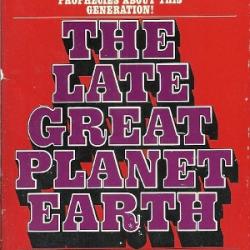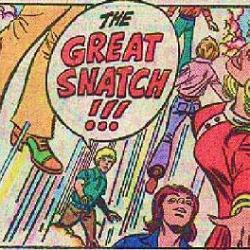Nicolae: The Rise of Antichrist; pp. 318-322
Rayford Steele is preaching through the notes for what would have been Bruce Barnes’ final sermon. That sermon is intended to inform the congregation of the dire events they can expect to live through — or to die through — during the Great Tribulation. Granted, this information might have been more helpful and practical 18 months ago, before the Tribulation really got going, but better late than never, I suppose.
“Here’s what Bruce, in his own notes, says is yet to come:
“‘The time is short now for everyone. Revelation 6:7-8 says the rider of the pale horse is Death and that Hades follows after him. Power was given to them over a fourth of the earth, to kill with sword, with hunger, with death, and by the beasts of the earth …'”
This is Bruce’s interpretation of Revelation 6:7-8. It is also Bruce’s verbatim recitation of Revelation 6:7-8. Rayford and the New Hope congregation hanging on his every word are convinced that they needed Bruce’s “scholarship” to help them understand what they believe Revelation prophesies is about to occur. They treat that text like an impenetrable mystery they could never hope to understand on their own without Bruce’s help. But then Bruce’s help turns out to be nothing more than simply quoting from the text. Rayford doesn’t think either he or his audience are qualified to read this passage for themselves, so instead he reads it from Bruce’s notes.
At least now we have some idea of what Bruce was actually doing during all those hours of “prophecy study” in the pastor’s office. He was apparently just transcribing long passages from Revelation into his hand-written “notes.”
Here’s the only bit of actual “interpretation” that Bruce provides for understanding this
“I confess I don’t know what the Scripture is referring to when it says the beasts of the earth. … Perhaps a great beast of the earth is some symbolic metaphor for the weapons employed by the Antichrist and his enemies. Regardless, in short order one-fourth of the world’s population will be wiped out.”
Anyone who reads Revelation “literally” will clearly see that “the beasts of the earth” is a “symbolic metaphor” for nuclear weapons. Duh.
Rayford looked up from Bruce’s notes. “My wife and I watched the news yesterday at the airport,” he said. …
The Milwaukee airport, of course, given that O’Hare was obliterated by a nuclear attack the same day that Bruce died from his disease during the bombing of his hospital.
“… as I’m sure many of you watched from wherever you were, and we saw these very things reported from all around the world.”
They saw these things reported on CNN. Some day, later on, maybe, those events may also be reported in the pages of Global Weekly — but only if Verna Zee figures out some way of working around behind the back of her do-nothing boss.
“Only the greatest skeptic would accuse us of having written this after the fact. But let’s say that you’re skeptical. Let’s say you believe we are charlatans. Who then wrote the Bible? And when was it written? Forget Bruce Barnes and his present-day predictions, a week before the fact. Consider these predictions made thousands of years ago.”
This note to skeptics isn’t intended for anyone in Rayford’s audience. Those (fictional) people, after all, are all people who came to New Hope Village Church and belatedly became real, true Christians because they had already seen the (fictional) Rapture as proof of the Bible-prophecy scheme Rayford is describing. Rayford’s challenge to skeptics here is directed, rather, to non-RTC readers of the Left Behind series. It’s intended to prove that the authors cannot be dismissed as charlatans because their fictional portrayal of the fulfillment of “Bible prophecy” constitutes proof of what they’re saying.
Again, LaHaye and Jenkins’ insistence on making this fiction-as-proof argument is probably the second-weirdest thing I’ve ever seen. The weirdest would be, of course, the fact that millions of their readers seem to accept this argument.
This brings us to Bruce’s explanation for why, more than a year after the Rapture, he’s only just now starting to preach to his congregation about the next set of awful “prophecies” they’re about to see fulfilled:
“You can imagine the pain it brought Bruce to have to prepare this sermon. In a side note he writes, ‘I hate preaching bad news. … I must share more bad news in this message, and though it grieves me, I cannot shirk the responsibility.'”
“You’ll note Bruce’s turmoil here,” Rayford said. “Because I’m the one who has to deliver this, I empathize totally with where he was.”
Up until now, apparently, Bruce has been “shirking” the preaching of bad news. His previous sermons, I guess, emphasized all the good parts of the Great Tribulation. I’d kind of like to read some of those shiny, happy Tribulation sermons, because I’m still not sure what that could mean. The whole idea of the Great Tribulation is supposed to be that it doesn’t have any good parts.
Rayford breezes through the next little bit, about the “Four Horsemen of the Apocalypse … visit[ing] their judgments on the earth.” This refers to the conquest, war, famine and death now underway — judgments previously undiscussed at New Hope Village Church, but which the congregation has been living through for weeks now. Rayford/Bruce has little to say about any of that — no words of encouragement, or survival tips, or prayers for protection. He instead mentions these current tribulations only as an excuse to further expound on the proprietary details of Tim LaHaye’s personal revision of the standard premillennial dispensationalist timeline:
“… the Four Horsemen … represent the first four of the seven Seal Judgments that Revelation 6:1-16 indicates will occur during the first 21 months of the Tribulation. According to Bruce’s calculations, using as a reference point the treaty signed between Israel and the United Nations, which we now know as the Global Community, we are closing in on the end of that 21-month period. …”
For a tiny fragment of LaHaye’s readers, this constitutes fightin’ words. Take that mid-Tribbers with your patently unbiblical two-42-month-period scheme and your heretical use of the Rapture as the starting point. As this fictional account proves, real, true prophecy scholars all agree that the peace treaty is the starting point, followed by four 21-month periods. Hah!
For the rest of us, this passage is remarkable mainly for Rayford’s ability to make global war, famine and calamity sound dull.
“Therefore, it behooves us to understand clearly the fifth, sixth, and seventh Seal Judgments predicted in Revelation.”
OK, better. Rayford has no patience to further discuss the calamities that this congregation is facing at this very moment, but for the 75 percent of them who survive this first 21 months of the Great Tribulation, it really does behoove them to understand — and to maybe even prepare for — the next three items in the End of the World itinerary. Here, at last, Rayford comes to the vital, urgent part of Bruce’s sermon.
“I’m going to ask for just a five-minute break. I know many of you may need to use the facilities. I need to get a drink. We’ll meet back here at precisely one o’clock.”
He left the platform …

Let’s all go to the lobby. Let’s all go to the lobby. …
Amanda rushes up during this oddly scheduled break to assist her husband:
“What do you need?” she asked.
“Besides prayer?”
“I’ve been praying for you all morning,” she said. “You know that. What do you want? Some orange juice?”
“You make me sound like a diabetic.”
All morning, Amanda has been praying that God would guide Rayford’s preaching. She forgot to pray that he’d be less of a jerk every time she offered to do anything for him.
Jerry Jenkins has spent the past dozen or so pages repeatedly telling us that Rayford Steele is a spiritual giant, a sincerely passionate and passionately sincere source of religious wisdom and leadership for this congregation. And then, for no apparent reason, he pauses Rayford’s sermon just to inject a little interlude in which we see Rayford getting all irritable and defensive about almost being accused of being a sinful diabetic.
But don’t let the strangeness of that distract from what’s even stranger in this scene. Amanda rushes off and gets her husband some orange juice. No problem with that. Of course there’s some OJ in the church kitchen. Why wouldn’t there be?
Well, let’s go back to Revelation 6 and to those Four Horsemen still galloping across the world. Here’s the description of the third one from that passage:
When He opened the third seal, I heard the third living creature say, “Come and see.” So I looked, and behold, a black horse, and he who sat on it had a pair of scales in his hand. And I heard a voice in the midst of the four living creatures saying, “A quart of wheat for a denarius, and three quarts of barley for a denarius; and do not harm the oil and the wine.”
This is global famine. Hunger on such a massive, desperate scale that, according to Bruce Barnes, “in short order one-fourth of the world’s population will be wiped out.” And yet there’s no problem getting orange juice in Mount Prospect, Illinois.
While Amanda rushes off to the fully stocked church kitchen, Buck joins Rayford in the hallway.
“Do you think they’re ready for what’s to come?” Buck asked.
“Frankly, I think Bruce has been trying to tell them this for months. There’s nothing like today’s newscasts to convince you your pastor is right.”
It is quite convincing. Just after the massive global famine hits, Rayford stands in the pulpit and tells them that Bruce was very nearly ready to offer his prediction of massive global famine. Now it has arrived — just as Bruce almost was going to later predict. They have all seen reports of such famine on “today’s newscasts,” depressed by having to watch such hateful bad news while they eat a second helping of their plentiful meals and wash it down with a big glass of orange juice.












